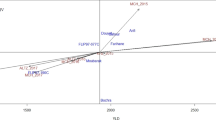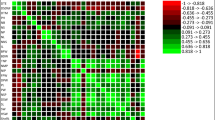Summary
Chickpea (Cicer arietinum L.) experiments were conducted at three locations (Tel Hadya and Jindiress in Syria and Terbol in Lebanon), over two seasons (winter and spring) for three years (1983–84, 1985–86 and 1986–87) to identify stable lines. Analyses of variance were done to study the genotype-environment interactions and analysis of stability was done to determine the performance of lines in varying environments. Results showed significant differences between mean of the seasons and locations and lines for all characters in all the three years except for biological yield in 1985–86 and plant height in 1986–87. Genotype × season interactions at each location were highly significant for all characters in all years, suggesting that most genotypes responded differently to each season. Genotype×environment (linear) interactions were significant for all characters, except seed yield and biological yield in 1983–84. The significant pooled deviations for all characters, except seed yield and biological yield in 1983–84 and 1985–86 showed that prediction of performance of these lines is not possible. Some lines were high yielders but sensitive to changing environments, while other lines were resistant to changing environment but average yielders. This study, therefore, suggests that cultivars have to be bred separately for winter and spring seasons, and for favourable and unfavourable environments. Joint contribution from the International Center for Agricultural Research in the Dry Areas (ICARDA), P.O. Box 5466, Aleppo, Syria and the International Crops Research Institute for the Semi-Arid Tropics (ICRISAT), Patancheru P.O., A.P. 502 324, India.(XX)
Similar content being viewed by others
References
Allard R.W. & A.D. Bradshaw, 1964. Implications of genotype-environmental interactions in applied plant breeding. Crop Sci. 4: 503–507.
Eberhart S.A. & W.A. Russel, 1966. Stability parameters for comparing varieties. Crop Sci. 6: 36–40.
Finlay K.W. & G.N. Wilkison, 1963. The analysis of adaptation in a plant breeding programme. Aust. J. Agric. Res. 14: 742–754.
Hill J., 1975. Genotype-environment interaction—a challenge for plant breeders. J. Agric. Sci. 85: 477–493.
Jain K.C., B.P. Pandya & K. Pande, 1984. Stability of yield components of chickpea genotypes. Indian J. Genet. 44: 159–163.
Singh J. & K.C. Bains, 1984. Stability analysis of varietal mixtures in chickpea (Cicer arietinum L.). Z. Pflanzenzuchetg. 92: 159–169.
Singh K.B., R.S. Malhotra & Singh Harbans, 1979. Phenotypic stability in Cicer arietinum L. Genet. Agr. 33: 191–200.
Singh R., H.S. Hadav & P. Singh, 1986. Stability analysis for grain yield in gram (Cicer arietinum L.). Sci. Cult, 52: 204–205.
Author information
Authors and Affiliations
Rights and permissions
About this article
Cite this article
Singh, K.B., Bejiga, G. Analysis of stability for some characters in Kabuli Chickpea. Euphytica 49, 223–227 (1990). https://doi.org/10.1007/BF00036292
Received:
Accepted:
Issue Date:
DOI: https://doi.org/10.1007/BF00036292




